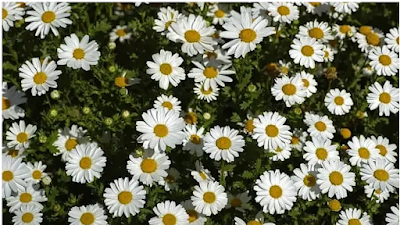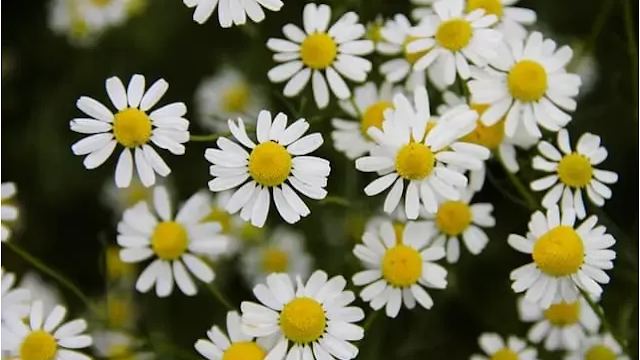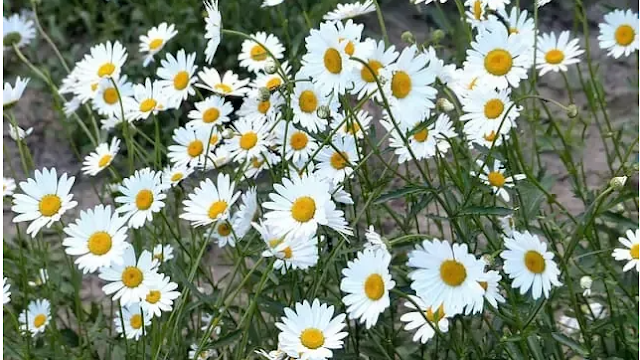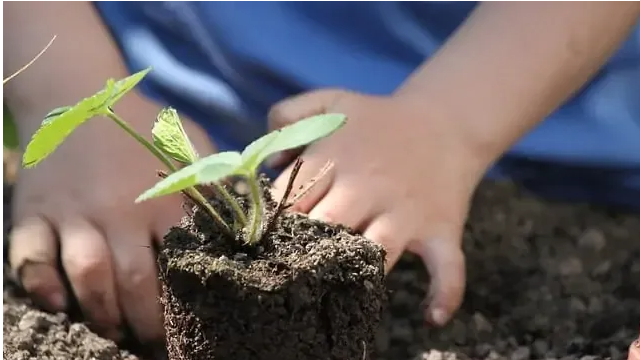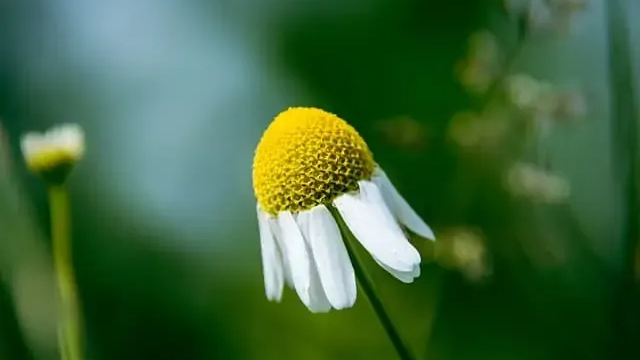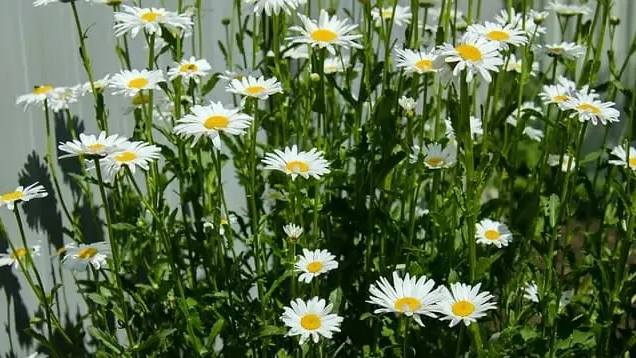By HappyDIYHome
Both useful and attractive, the chamomile plant is a versatile addition to the garden. Classified as a herb, the chamomile plant is actually a member of the Asteraceae or daisy family.
The chamomile plant has been grown for its medicinal and herbal properties for many years. A popular herbal skin care treatment, the foliage can also be used as a seasoning or to make chamomile tea. Meanwhile, the daisy-like flowers, with their large yellow centres surrounded by a circle of white leaves, add colour and interest to the garden. As well as being ornamentally attractive the flowers are also a good pollinator magnate, drawing scores of beneficial insects into your garden.
Useful and attractive, if you want to add a chamomile plant to your garden this guide will take you through everything that you need to know.
The German variety is an annual specimen. Capable of self-seeding, it is often mistakenly believed to be a perennial. German varieties reach a height of 24 to 36 inches, depending on the growing conditions. Whilst they are taller than the Roman variety, German types are more compact, rarely spreading out more than 12 inches. As they grow, German specimens produce branching stems covered with fern-like foliage and large, daisy-like flowers. This plant is commonly used to make a soothing, herbal tea.
The Roman variety is not as tall as the German type. It rarely exceeds 12 inches. However, the Roman plant enjoys a wider spread. Depending on the growing conditions these flowers can achieve a spread of between 18 and 24 inches. This makes it a good ground cover choice. Alternatively, Roman flowers look particularly attractive spilling over the edges of walls, pots or flower beds.
A perennial flower, the Roman variety is also known as Russian or English chamomile. This variety is particularly suited to underplanting taller flowers or herbs.
Roman types are spread by rooting stems. Their hairy stems hold just one flower and have a fine, feathery foliage.
While German varieties tend to flower more abundantly, the Roman type is more fragrant.
The German chamomile plant is hardy in USDA Zones 2 to 9. The Roman variety is hardy in zones 4 to 11.
Both German and Roman types are quick to grow and flower. They also enjoy similar growing needs and requirements.
Growing from Seed
The chamomile plant is easy to grow from seed. Start seeds undercover around 6 weeks before your last predicted frost date.
Fill starter trays with a balanced seed starter soil mix and moisten. Scatter the seeds as thinly as possible. Do not cover the seeds with more soil. Chamomile plant seeds need light to germinate. Instead of covering them, place a lid on the trays, or place in a plastic bag. These Seed Starter Trays not only come with fitted lids, but are divided into cells. This makes it easier for you to space out your seeds.
Do not allow the seed starter mix to dry out. A Yebeauty Plant Mister provides a fine, gentle spray. This enables you to keep the soil moist without disturbing or drowning the seeds.
Germination typically occurs within 14 days
Alternatively, you can also sow the seeds directly into their final growing position. For the best results, directly sow the seeds in the fall. This allows them to stratify over the winter before germinating in the spring. You can also directly sow the seeds in late winter. Sow 3 to 4 weeks before your area’s last predicted frost date.
Work the soil over before watering. Sow the seeds as thinly as possible and before lightly covering them with a fine layer of vermiculite or fresh soil.
Following germination, continue to regularly water the soil. When the seedlings reach an inch in height, thin out to a spacing of 2 to 4 inches. This gives them plenty of room to develop.
Where to Position your Flowers
Both German and Roman types like full sun positions and good, well-draining soil.
Before sowing or planting you can work in a little compost or organic matter to improve the soil, but don’t add too much. These flowers struggle in overly rich soil. Additionally, growing in soil that is too poor or lacking in nutrients can cause specimens to become floppy. Ideally, the pH level should be between 5.6 and 7.4.
In warmer or hot climates position the flowers in partial shade. This protects the foliage and flowers from burning under the intense heat of the afternoon sun. While planting in full sun encourages quick growth, the chamomile plant has a naturally quick growth habit. This means that growing in partial shade rarely slows it down.
Finally, the chamomile plant thrives in temperatures below 100 ℉. Ideally, the temperature should range between 60 and 68 ℉.
How to Plant
If you have started the seedlings off undercover, remember to harden them off before transplanting. As the seedlings acclimatize you can prepare the planting area by weeding and working in any necessary amendments. If you are unsure how to properly harden off your seedlings, this guide takes you step by step through the process.
When the seedlings are ready for transplanting, make a hole in the soil large enough to easily hold the entire root system. Remove the seedling from the tray. Be careful not to damage the root system as you do this.
Position the seedling in the hole, it should sit at roughly the same level as when it was in the tray. Backfill the hole and water well.
Planting in Pots
The Roman chamomile plant also thrives in containers. A 12-inch wide pot holds one flower. The German variety likes a lot of space and, unless you have a large pot or barrel, are better suited to growing in the ground or a raised bed.
Your chosen container should be clean and have lots of drainage holes in the bottom. Fill with a loose, well-draining potting soil mix. Plant as described above.
In warmer climates, if temperatures exceed 90 ℉, move the pot to a shady spot. In the fall, before the first frosts arrive, move the pots undercover or indoors. A plant caddy enables you to easily move heavy pots around your home or garden.
Positioning Indoors
As well as being a good garden and herb garden specimen, these flowers also make good indoor or houseplants.
Place the pot in a light position. The specimen should receive 4 hours of light every day. A south-facing windowsill is ideal.
While the chamomile plant can grow indoors, the growth rate may be slower. Additionally, flowers growing indoors tend to be smaller than outdoor specimens. They rarely exceed 10 inches in height.
How to Care for a Chamomile Plant
Wherever you chose to grow your chamomile plant, how you care for it is largely the same.
Regularly weed the soil around the flowers. Here are some great weedding tools to help you keep your garden neat and tidy.
Water
Immediately after planting water the soil well. Continue to water regularly until the flowers are established and new growth is visible. At this stage, you can reduce watering.
Once established, these are drought tolerant flowers. Allowing the top half-inch of soil to dry out between waterings helps to prevent rot related issues developing.
Fertilizer
If placed in good soil there is no need to fertilize the chamomile plant. Even a little dose of fertilizer can encourage a large growth spurt. For this reason, some people consider the chamomile plant to be invasive. Additionally, too much fertilizer can cause the levels of essential oils present in the foliage to decrease.
Pruning
Regularly trim back specimens to keep them healthy and prevent legginess. This is particularly important if you are growing a Roman variety and want to control its spread.
Healthy clippings can be used in a range of herbal remedies and teas. They can also be placed in the compost bin or spread around the garden. Some gardeners think that placing some chamomile plant clippings around struggling specimens can give them a boost.
Companion Planting
A popular companion plant, the flowers attract a number of pollinators and beneficial insects to the garden. The scent also deters ticks and mosquitos.
Planting close to basil and mint can help to improve both the taste and scent of these herbs.
The chamomile plant adds various antifungal and antibacterial benefits into the soil. This can help to improve the flavor and growth of a number of fruit and vegetables including:
Apple trees,
Beans,
Broccoli,
Brussels sprouts,
Cabbage,
Cauliflower,
Cucumbers,
Kale,
Onions.
Other flowers and shrubs that benefit from growing close to or alongside these beneficial flowers include:
Astilbe,
Bee balm,
Black-eyed Susan,
Bleeding heart,
Delphinium,
Dogwood
Lilacs,
Lungwort,
Petunias,
Phlox,
Roses,
Snapdragon,
Verbena,
Zinnias,
Finally, chamomile tea can be sprayed onto other seedlings to prevent damping off.
Common Pests and Problems
A low maintenance choice, most common garden pests avoid these attractive flowers. For this reason it is a popular companion choice.
Aphids and thrips can target the foliage. If you notice any infestations blast the pests away with a garden hose. More serious infestations can be treated with a dose of neem oil. This guide to using neem oil in the garden explains exactly how you can use the essential oil in your garden.
Powdery mildew may develop during long spells or hot, damp weather.
Propagating a Chamomile Plant
The chamomile plant can be propagated in a number of different ways.
Perennial Roman types can be propagated by division. This is best done in early spring before new growth emerges. Divisions are best taken from flowers that are at least 2 years old. To divide, dig down all around the flower. Use your fork or spade to lift the entire root system as one.
Brush away any remaining soil and closely inspect the root system. Any diseased or damaged sections should be cut away and discarded. Separate the remaining healthy root into 3 to 5 even sections. Use a sharp knife to cut through the roots. Each section should have a healthy amount of roots and, if present, healthy foliage.
Replant the newly created sections in fresh soil as described above.
Taking Successful Cuttings
Both German and Roman types can be propagated by cuttings.
The day before taking your cuttings, water the roots and surrounding soil deeply. This ensures that the plant is fully hydrated and better able to cope with transplant stress.
Take the cuttings the next morning. The ideal cutting will be a 4 to 5 inch long stem with lots of foliage, a thick healthy base and no flowers.
Identify a healthy stem. Dig into the soil to find the base of the stem. The base will be white in color and should, if it is healthy, have some roots. Use a sharp knife to cut the stem roughly half an inch below ground level.
Place the cutting in a 4 inch pot filled with 3 parts potting soil and 1 part perlite. Water well before placing it in a shady corner of the greenhouse to root. Apply 1 inch of water once a week. If successful, new growth emerges within 6 to 8 weeks.
Harvesting Seeds
Allow spent flowers to remain on the stem. As they fade, seeds start to form in the central yellow section. Cut the dried flower head away from the stem and rub over a bowl. This collects the seeds. To separate the tiny seeds from the chaff, try straining the seeds through a sieve or Fine Mesh Strainer.
Seeds can be stored in a labeled envelope or jar in a cool, dry position. They remain viable for 3 to 4 years.
If you find harvesting the small seeds difficult, remember that German types reseed readily. Simply allow the spent flowers to fade on the stem. The ripe seeds fall to the ground and, the following spring, germinate. When large enough to handle, dig up the seedlings and transplant into a new position.
How to Harvest Flowers
The flowers can be cut away as soon as they fully open. They can either be used fresh or dried and stored for later use. The foliage can also be cut away and used in teas or herbal remedies.
The best time to harvest the foliage or flowers is in the morning after the dew has dried and the essential oils are at their peak.
To remove a flower, pinch the stem just below the flower head. Use your forefinger and middle finger to twist and remove the flower from the stem.
Dry the flowers by placing them in a single layer, as flat as possible, on a paper towel in a warm, dry, dark place. It can take between 1 and 2 weeks for the flowers to completely dry. You can also place the flowers in a dehydrator on the lowest setting.
When fully dry, flowers can be stored in an airtight glass jar for up to 6 months.
Flowering within 10 weeks of germination, the chamomile plant is a fast growing, fragrant specimen. Providing masses of soft foliage and daisy-like flowers the chamomile plant is both a useful and visually pleasing addition to the garden.
*First Published August 13, 2021 by HappyDIYHome







